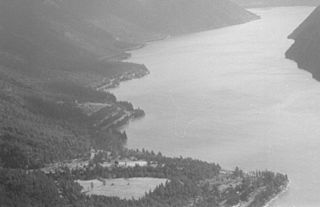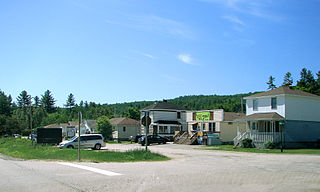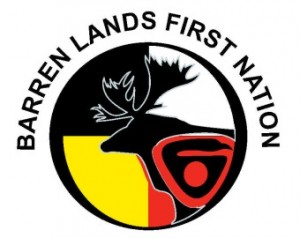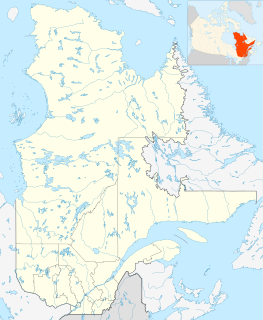Related Research Articles

Abitibi—Témiscamingue is a federal electoral district in Quebec, Canada, that has been represented in the House of Commons of Canada since 2004. The area was also represented by the electoral district of Témiscamingue from 1968 until 2004.

Témiscaming is a city located at the south end of Lac Témiscamingue on the upper Ottawa River in the Témiscamingue Regional County Municipality of western Quebec, Canada. Also nearby is Lake Kipawa.

The Musqueam Indian Band is a First Nations band government in the Canadian province of British Columbia and is the only First Nations band whose reserve community lies within the boundaries of the City of Vancouver.
N'Quatqua, variously spelled Nequatque, N'quat'qua, is the proper historic name in the St'at'imcets language for the First Nations village of the Stl'atl'imx people of the community of D'Arcy, which is at the upper end of Anderson Lake about 35 miles southeast of Lillooet and about the same distance from Pemberton. The usage is synonymous with Nequatque Indian Reserve No. 1, which is 177 ha. in size and located adjacent to the mouth of the Gates River.

Mishkeegogamang First Nation is an Ojibway band government in the Canadian province of Ontario. Until 1993, the band was called the Osnaburgh First Nation, with various settlements at times being called New Osnaburgh, Osnaburgh House, or Osnaburgh.

Lake Kipawa is a lake in far south-west Quebec, Canada, near the border with Ontario, north of Témiscaming, Quebec. Also see Kipawa River which is the only natural outflow of Kipawa Lake, Gordon Creek in Témiscaming on the south end being artificial.
[[Image:Kebaowek First Nations .jpg|thumb|right|230px|Welcome Kipawa Indian Reserve, also known as Kebaowek, is a First Nations reserve in Abitibi-Témiscamingue, Quebec. It is under the governance of the Eagle Village First Nation - Kipawa.

The Bonaparte Indian Band a.k.a. Bonaparte First Nation, is a member band of the Shuswap Nation Tribal Council of the Secwepemc (Shuswap) people.
The Ashcroft First Nation is a First Nations government Thompson Canyon area of the Central Interior of the Canadian province of British Columbia. Its Indian Reserves are located near the town of Ashcroft, British Columbia, it is a member of the Nlaka'pamux Nation Tribal Council.

The Seton Lake First Nation, a.k.a. the Seton Lake Indian Band, is a First Nations government located in the Central Interior-Fraser Canyon region of the Canadian province of British Columbia. It is a member of the Lillooet Tribal Council, which is the largest grouping of band governments of the St'at'imc people. Other St'at'imc governments include the smaller In-SHUCK-ch Nation on the lower Lillooet River to the southwest, and the independent N'quatqua First Nation at the farther end of Anderson Lake from Seton Portage, which is the location of three of the band's reserve communities.

The Lil'wat First Nation, a.k.a. the Lil'wat Nation or the Mount Currie Indian Band, is a First Nation band government located in the southern Coast Mountains region of the Interior of the Canadian province of British Columbia. It is a member of the Lillooet Tribal Council, which is the largest grouping of band governments of the St'at'imc or Stl'atl'imx people. Other St'at'imc governments include the smaller In-SHUCK-ch Nation on the lower Lillooet River to the southwest, and the independent N'quatqua First Nation at the near end of Anderson Lake from Mount Currie, which is the main reserve of the Lil'wat First Nation, and also one of the largest Indian reserves by population in Canada.

Fond du Lac Dene Nation is a Dene First Nation located in the boreal forest area of northern Saskatchewan, Canada. The main settlement is Fond-du-Lac, situated on the east side of Lake Athabasca. It is a remote fly-in community. The population in 2011 was 874, mainly of Dene and Métis descent. 705 residents selected Dene as their mother tongue in 2011.

Thorne is an unincorporated community within the unincorporated township of Poitras, in the Canadian province of Ontario. It is located in the census division of Nipissing District. A designated place served by a local services board, the community had a population of 204 in the 2016 Canadian Census.

Kipawa is a village and municipality in western Quebec, Canada, in the Témiscamingue Regional County Municipality. It is located at the south end of Lake Kipawa, adjacent to the Kebaowek Reserve. The land including and surrounding Lake Kipawa and Kipawa Village has been inhabited for centuries. The original inhabitants are the Algonquin people. The first Europeans to come into Kipawa were fur traders and missionaries. Shortly after, The Hudson Bay Trading Company and various other lumber companies settled there, including Commonwealth Plywood.

Jurkowo is a village in the administrative district of Gmina Krzywiń, within Kościan County, Greater Poland Voivodeship, in west-central Poland. It lies approximately 3 kilometres (2 mi) north-west of Krzywiń, 15 km (9 mi) south-east of Kościan, and 48 km (30 mi) south of the regional capital Poznań.

Klenica is a village in the administrative district of Gmina Bojadła, within Zielona Góra County, Lubusz Voivodeship, in western Poland. It lies approximately 5 kilometres (3 mi) north-west of Bojadła and 20 km (12 mi) east of Zielona Góra.
Dunes-de-la-Moraine-d'Harricana Ecological Reserve is an ecological reserve in Quebec, Canada. It was established on August 19, 1994.
Takla Landing, also known as McLaing Landing is an unincorporated locality and former steamboat landing on the east side of Takla Lake in the Omineca Country of the Central Interior of British Columbia, Canada. In the days of the Omineca Gold Rush, Takla Landing was a port for steamboats connecting trails from Hazelton, British Columbia via Babine Lake to trails leading from Takla Landing eastwards to the area of the gold strikes in the lower Omineca River.

Barren Lands First Nation is a First Nation located on the north shore of Reindeer Lake in northern Manitoba close to the Saskatchewan border. It has one territory called Brochet 197 which is 4339.40 hectares in size and adjoins the village of Brochet, Manitoba.

The ZEC Kipawa is a "zone d'exploitation contrôlée" (ZEC), located in the unorganized territory Les Lacs-du-Témiscamingue, in the Témiscamingue Regional County Municipality, in the administrative region of Abitibi-Témiscamingue, in Quebec, in Canada. Annually, the outdoor activities on the ZEC are intense from May to October, with camping, mountain biking, hunting, fishing and walking in the forest trails. The mission of the ZEC includes the protection of flora and fauna.
References
- ↑ "Indian and Northern Affairs Canada Reserves/Settlements/Villages Detail". Archived from the original on 2016-03-04. Retrieved 2013-07-19.
- 1 2 "Interview with Mike McKenzie and Francis Robinson". Témiscaming 1921-1996: nos racines, notre histoire (in French). Book Committee: Louise Forget, Yolande Dumas, Julienne Cécire, Thérese Gélineau, Ken Collins, Ross Sparling, Philippe Barette, Shirley McCullock, Marjorie Brown, Linda Lamarhe, Pierre Bérubé, Gerry Jones, Peter McCulloch, Lois Lynn. Témiscaming?: s.n. 1996. p. 358. ISBN 9782980420603. OCLC 936856576.CS1 maint: others (link)